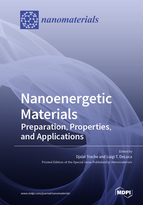Nanoenergetic Materials: Preparation, Properties, and Applications
A special issue of Nanomaterials (ISSN 2079-4991). This special issue belongs to the section "Energy and Catalysis".
Deadline for manuscript submissions: closed (31 October 2020) | Viewed by 45653
Special Issue Editors
Interests: bio-based materials; nanocellulose; nanomaterials; characterization; analytical methods; thermal analysis; kinetics; advanced materials; nanoenergetic materials; propellant; energetic materials; multifunctional polymer composites and nanocomposites
Special Issues, Collections and Topics in MDPI journals
Special Issue Information
Dear Colleagues,
The advancement in the synthesis approaches and the advent of tools of characterization of materials at multiple length scales have pushed the energetic materials community to explore new era. During the past two decades, several significant achievements in research on nanoenergetic materials (nEM) have been realized, thanks to the technological novelties in the field of nanoscience and nanotechnology. nEM have been found to be potential sources of extremely high heat release rates and tailored burning rates, reliability, extraordinary combustion efficiency, safety, and reduced sensitivity. These materials certainly play a vital role in widespread applications. The improvement of properties and the discovery of new functionalities and methodologies are key goals that cannot be reached without a better understanding of the preparation, characterization, manufacturing, and properties that constitute the starting points of the design of specific and adequate systems. The investigation of nanoenergetic materials has demonstrated both the academic and technological importance of, and offered great research opportunities within, cross-disciplinary areas. In our opinion, the applied aspects of such nanomaterials should get proper attention now and bring an interdisciplinary effort to address the various challenging issues researchers have been confronted with in this field in relation to a number of applications.
This Special Issue of Nanomaterials will attempt to publish high-quality short communications, research papers covering the most recent advances, as well as comprehensive reviews addressing novel and state-of-the-art topics from active researchers in nano-energetic materials, concerning not only the synthesis, preparation, and characterization of properties but especially focusing on the current and emerging applications of such nanomaterials with outstanding performances. Potential nano-energetic materials topics include but are not limited to the following:
- The synthesis, characterization, and properties of nano-energetic materials with outstanding properties for next-generation applications;
- The modification of nano-energetic materials;
- The synthesis, characterization, and properties of nano-additives (catalysts, plasticizers, and coating agents) for energetic materials formulations;
- Nano-energetic materials application (aerospace, defense, energy storage, the microelectromechanical system, automotive, micro-actuation, micro-fluidics, welding, and other applications).
Prof. Dr. Djalal Trache
Prof. Dr. Luigi T. Deluca
Guest Editors
Manuscript Submission Information
Manuscripts should be submitted online at www.mdpi.com by registering and logging in to this website. Once you are registered, click here to go to the submission form. Manuscripts can be submitted until the deadline. All submissions that pass pre-check are peer-reviewed. Accepted papers will be published continuously in the journal (as soon as accepted) and will be listed together on the special issue website. Research articles, review articles as well as short communications are invited. For planned papers, a title and short abstract (about 100 words) can be sent to the Editorial Office for announcement on this website.
Submitted manuscripts should not have been published previously, nor be under consideration for publication elsewhere (except conference proceedings papers). All manuscripts are thoroughly refereed through a single-blind peer-review process. A guide for authors and other relevant information for submission of manuscripts is available on the Instructions for Authors page. Nanomaterials is an international peer-reviewed open access semimonthly journal published by MDPI.
Please visit the Instructions for Authors page before submitting a manuscript. The Article Processing Charge (APC) for publication in this open access journal is 2900 CHF (Swiss Francs). Submitted papers should be well formatted and use good English. Authors may use MDPI's English editing service prior to publication or during author revisions.
Keywords
- Nanoenergetic material
- Nanothermite
- Propellant
- Explosive
- Nano-oxidizer
- Nano-fuel
- Nano-polymer
- Nanocomposite
- Nano-catalyst
- Carbon nanomaterial
- Nano-coating
- Preparation method
- Characterization
- Properties
- Performance
- Application.








